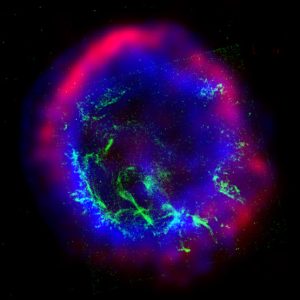
Two astrophysicists are proposing that the identity of the invisible source of the majority of the gravitational glue that holds galaxies together—otherwise known as dark matter—may be a hypothetical particle that travels faster than the speed of light that was first introduced over half a century ago. These superluminal particles, better known as tachyons, could also account for the accelerated expansion of the universe, meaning that, aside from the vast majority of the universe’s mass travelling faster than light, the effects of dark matter and dark energy would stem from the same invisible particle, instead of being two separate phenomena.
Although most physicists believe they don’t exist, the idea of tachyons was first introduced by physicist Gerald Feinberg in 1967, described as particles that always travel faster than light, a property that would mean that they also travel backward in time. This superluminal aspect would effectively render the particles invisible from our point of view—we have no method of detecting anything travelling faster than light/backward in time—but the gravitational mass of the particles could still affect the visible universe as they streak backward in time through our present moment.
Part of the rationale behind a tachyon-based model is that the expansion of a universe filled with such speedy particles would slow shortly after coming into existence, followed by a reacceleration of that expansion, something our universe appears to have done: following the Big Bang, universal expansion had been slowing until about five billion years ago when it inexplicably started speeding up again. The phenomenon behind this reaccelerated expansion is referred to as dark energy, a hypothetical form of energy that comprises a little more than two-thirds of the universe (dark matter and ordinary matter make up most of the remaining 26 and five percent, respectively).
While dark energy is causing everything in the universe to fly away from itself with ever increasing speed, the gravitational pull of dark matter is what is keeping the larger structures in it, like galaxies and the extremely large filaments they form, from disintegrating altogether. Observations made in the 1970s of the motion of galaxies revealed that the stars that make up these structures did not have enough mass to keep the galactic disks from flying apart; it was calculated that to keep a galaxy together under their observed rate of spin would require five times more mass than what was visible, leading to the idea of dark matter, a phenomenon that exerts a gravitational force, but doesn’t interact with light or electromagnetic fields.
The authors of the tachyon-based universe model, Samuel H Kramer, with the University of Wisconsin-Madison, and Ian Redmount, Saint Louis University, tested their idea against recorded observations of a form of supernova called Type Ia supernovae, a type of stellar explosion that can be used to build a comparison between stellar distances and the universe’s rate of expansion. Kramer and Redmount found that the tachyon-based model worked just as well as the commonly-accepted dark energy/matter model at predicting universal expansion and large-scale gravitational influences.
While Kramer and Redmount’s idea isn’t expected to pan out, the exercise of using extremely exotic particles such as tachyons expands the field of potential solutions to a problem that has confounded physicists for more than half a century.
Subscribers, to watch the subscriber version of the video, first log in then click on Dreamland Subscriber-Only Video Podcast link.
On Oct. 9, 2022, telescopes in space picked up a jet of high energy photons careening through the cosmos toward Earth, evidence of a supernova exploding 1.9 billion light-years away. Such events are known as gamma ray bursts, and astronomers who have continued studying this one said it was the “brightest of all time.”
Now, a team of scientists have discovered that this burst caused a measurable change in the number of ionized particles found in Earth’s upper atmosphere, including ozone molecules, which readily absorb harmful solar radiation.
“The ozone was partially depleted — was destroyed temporarily,” said Pietro Ubertini, an astronomer at the National Institute of Astrophysics in Rome who was involved in discovering the atmospheric event. The effect was detectable for just a few minutes before the ozone repaired itself, so it was “nothing serious,” Dr. Ubertini said. But had the supernova occurred closer to us, he said, “it would be a catastrophe.”